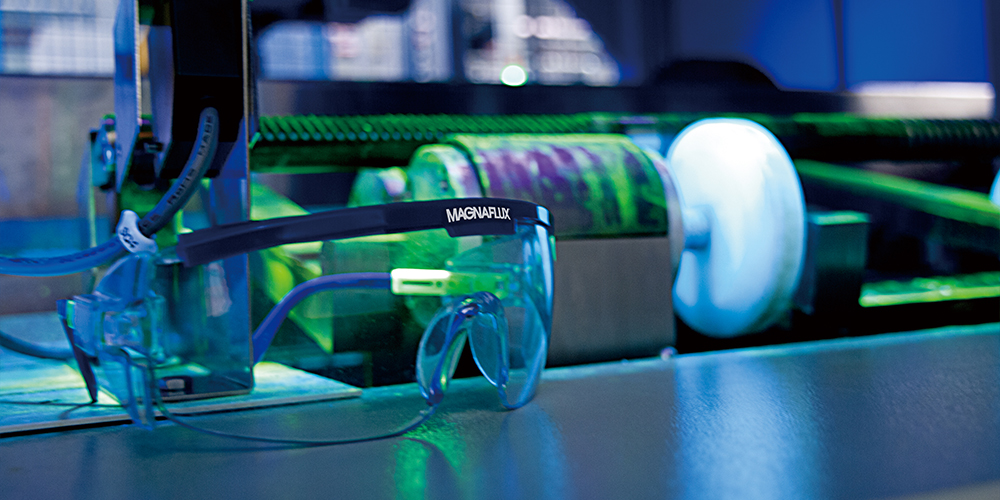
Industry codes and standards are published technical documents which establish procedures, instructions or specifications designed to maximize the reliability of products, materials and services by providing a uniformity across applications, companies, industries and countries.
The aim of all standards is to make products work better, make them safer, improve compatibility and address industry-specific concerns, but with many overlapping standards it can be difficult to know which ones make the most sense for you.
In this article we’ll give you the lowdown on two of the most common standards for NDT UV light sources, ASTM E2297 and ASTM E3022.
Standard Guide for Use of UV-A and Visible Light Sources and Meters used in the Liquid Penetrant and Magnetic Particle Methods
This document provides general information and requirements for traditional UV sources, UV radiometers and visible light meters when used in fluorescent nondestructive testing. E2297 applies equally to magnetic particle inspection (referenced by ASTM E1444 and ASTM E3024) and liquid penetrant testing methods (referenced by ASTM E1417 and ASTM E165).
For UV sources, E2297 provides details on mercury-vapor lamps and specialty lamps (LED lamps are covered by ASTM E3022). While the emission spectrum is slightly different with each type of lamp, all require a UV-A pass filter in order to ensure that only UV-A light is emitted.
- Mercury-vapor lamps come in two types: low-pressure (fluorescent tube lamps) and medium-pressure (hand held bulb lamps).
- Specialty lamps include borescopes, pencil lamps, micro-discharge lamps (MDL or MPXL), xenon lamps and high-intensity discharge (HID) lamps.
For UV radiometers, E2297 gives the proper sensitivity range and calibration required for fluorescent NDT applications. The UV-A range is defined as 320-400 nm, and a suitable radiometer must include filters to restrict the meter response to that range. Radiometers give readings in units of µW/cm2.
E2297 also gives the proper sensitivity range and calibration for visible light meters. For NDT, the visible light range is defined as 400-760 nm. And as with radiometers, the visible light meter must include filters to restrict the response to the proper range. Many meters on the retail level do not have the proper filters to measure in this range, and therefore would not be suitable for use in NDT applications. Visible light meters give readings of illuminance in units of foot-candles or lux.
One important note – E2297 advises that visible light meters do not have the ability to measure the visible emission from UV-A sources. That’s because they are not designed to measure low levels of visible light in the presence of intense UV-A, and the results are below the accuracy of the measurement system.
Standard Practice for Measurement of Emission Characteristics and Requirements for LED UV-A Lamps Used in Fluorescent Penetrant and Magnetic Particle Testing
This document establishes performance requirements for LED UV-A lamps. Like E2297, it applies equally to mag particle inspection (referenced by E1444 and E3024) and liquid penetrant testing (referenced by E1417 and E165). However, unlike E2297 which provides general information and requirements for NDT UV lamps, E3022 details procedures and data collection required for UV-A lamp manufacturers to certify their UV lamps for NDT use and is not intended to be referenced by UV lamp users.
For a UV-A light source lamp to be certified as E3022-compliant the manufacturer needs to perform two levels of certification: 1) model type testing to qualify the lamp design, and 2) individual unit testing to show a particular lamp is compliant.
- Model type testing includes a beam profile or plot, minimum working distance for a uniform beam, maximum lamp temperature during continuous operation, stabilization time (time from power-on until UV irradiance is stable), and UV-A pass filter transmission profile. Analysis of the emission spectrum is also required, both at ambient temperature and at the maximum rated operating temperature of the lamp. That analysis includes peak wavelength, full peak width at half maximum (FWHM), longest wavelength at half-maximum (LWHM), and irradiance in the excitation range (347-382 nm). Line-powered lamps require testing of LED drive current ripple; battery-powered lamps require a discharge plot or time until the irradiance drops below 1,000 µW/cm2. A manufacturer certificate, including the results from the model type tests, is required for each lamp model produced.
- Individual unit testing includes the emission spectrum (peak wavelength, FWHM, LWHM, and excitation irradiance) and the maximum irradiance at 15 in / 38 cm. A manufacturer certificate of conformance is required with each individual lamp.
While E3022 details the manufacturer requirements for LED lamps, it does not include checks performed by the user. Checks such as UV-A intensity and lamp integrity are the same with LED lamps as with other UV sources. User requirements for system performance checks on UV lamps are detailed in E165 or E1417 for penetrant testing, and E1444 or E3024 for magnetic particle testing.
Overview of NDT Standards Which Apply to UV Lighting
ASTM E1417 Instructions for performing liquid penetrant testing, including system performance checks for UV lighting. Commonly used by the Aerospace industry.
ASTM E1444 Instructions for performing magnetic particle testing, including system performance checks for UV lighting. Commonly used by the Aerospace industry.
ASTM E165 Instructions for performing liquid penetrant testing in general industrial applications, including system performance checks for UV lighting.
ASTM E2297 General information and requirements for traditional UV sources, UV radiometers and visible light meters when used in fluorescent nondestructive testing.
ASTM E3022 Performance requirements for LED UV-A lamps, intended primarily for UV lamp manufacturers.
ASTM E3024 Instructions for performing magnetic particle testing in general industrial applications, including system performance checks for UV lighting.
RRES 90061 Rolls-Royce specification for LED UV-A lamps, including requirements for both lamp manufacturers and users.
Interested in UV lamps with ASTM E2297 and ASTM E3022 certification? Check out the Magnaflux EV6000 hand-held LED UV lamp to see how it’s wide-beam and rugged construction can help you improve your NDT inspections.